Related Products
For Professionals
- Amplification
- Assessment of Student Skills, Challenges, Needs
- Early Childhood: Infants, Toddlers, Preschool
- Hearing Loss – Identification, Impact and Next Steps
- IDEA Law Summary Information
- Language and Speech Development Issues
- Legal Issues in Serving Children with Hearing Loss
- Listening (Auditory Skills) Development
- Planning to Meet Student Needs
- Self-Advocacy Skills for Students with Hearing Loss
- Self-Concept: How the Child with Hearing Loss Sees Himself
- Social Skills
- Speech Perception & Learning
Related Teacher Tools Takeout Items
What I Wish My Educators Had Known: 20 Tips from a Mainstreamed Deaf and Hard-of-Hearing (DHH) Individual
By: Kevin Glenn Garrison, Ph.D.
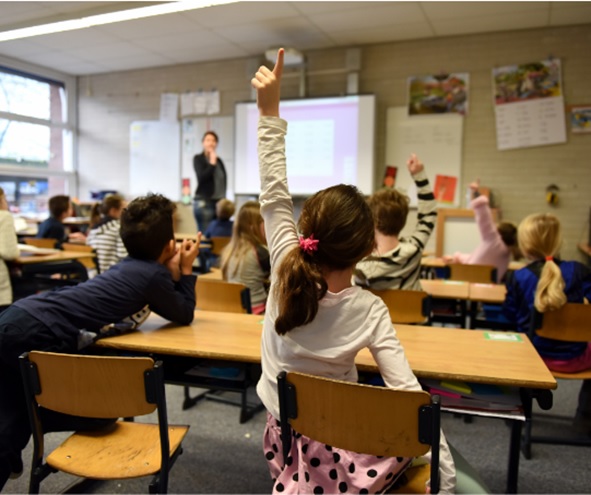
Introduction:
I am deaf and hard-of-hearing (DHH). During early childhood, my two sisters and I were diagnosed with progressive high-frequency hearing losses that slowly (and abruptly, at times) transitioned our identities from hard-of-hearing to deaf, and we were fitted for hearing aids, provided speech therapy, and mainstreamed for primary and secondary education. Despite our audiologist’s prediction that we would struggle with literacy beyond the fourth-grade level, my sisters and I graduated with both high school and college diplomas, and our narratives are sometimes touted as “mainstreamed DHH success stories.” Today, in my forties, I have a Ph.D. in English, and I am employed as a professor of technical communication at Angelo State University in San Angelo, Texas. In this brief piece, I provide educators of DHH students with what I wish my teachers had known when I was in K-12. These tips are from my experience, my sisters’ experiences, my DHH friends’ experiences, and the researched literature.
Disclaimer: These tips are not designed to replace an individualized education program (IEP). Please follow applicable laws, such as the Individuals with Disabilities Education Act (IDEA).
Sight, Not Sound:
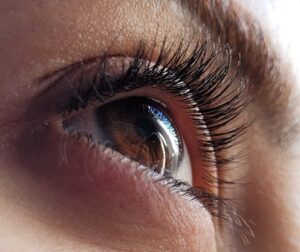 Most suggestions for teaching DHH students center around improving auditory outcomes: making sure hearing aids are fitted and turned on (with the batteries not run down), using cochlear implants, speaking in elevated tones and with more deliberate pronunciations, wearing FM systems that direct audio to receivers, and improving the acoustics of a classroom (e.g. minimizing background noise and peer voices). While these suggestions are necessary, they tend to minimize how most DHH individuals shift from the modality of hearing to the modality of sight as a primary mechanism for sensory input. DHH individuals are labeled as “people of the eye” (Lane, et. al, 2011) or as having an epistemology (a way of knowing and learning) that relies on vision (Hauser, et. al, 2010). The best educational outcomes from my education came from teachers who were self-conscious about their communication strategies and able to re-orient their pedagogy toward visuality. Suggestions include:
Most suggestions for teaching DHH students center around improving auditory outcomes: making sure hearing aids are fitted and turned on (with the batteries not run down), using cochlear implants, speaking in elevated tones and with more deliberate pronunciations, wearing FM systems that direct audio to receivers, and improving the acoustics of a classroom (e.g. minimizing background noise and peer voices). While these suggestions are necessary, they tend to minimize how most DHH individuals shift from the modality of hearing to the modality of sight as a primary mechanism for sensory input. DHH individuals are labeled as “people of the eye” (Lane, et. al, 2011) or as having an epistemology (a way of knowing and learning) that relies on vision (Hauser, et. al, 2010). The best educational outcomes from my education came from teachers who were self-conscious about their communication strategies and able to re-orient their pedagogy toward visuality. Suggestions include:
- Make sure that non-verbal communication strategies predominate, such as the ability to see lips, interpreters, hand gestures, closed captioning, and other educational materials (such as the white board).
- Institute a hand-raising policy for anyone who speaks in class; such slows down the flow of communication and allows for the DHH student to identify speakers and have a better chance of following the classroom discussion.
- Convert oral communications into visual communications. In one poignant memory, I recall attending a Shakespearean play during high school, but not knowing what was being “said,” despite the play being built off a visual modality (a script). I would have benefitted from having a copy of the play and a peer or teacher assigned to direct me visually (via sign, writing, or finger points) to the correct Act and Scene.
- Ensure adequate lighting, preferably rooms with windows and no curtains/shades (I recall a traumatic experience of being left behind when my kindergarten class was watching a movie in a dark room, and I did not realize that my classmates had left).
- Arrange physical spaces to allow the DHH child to see as much of the visual landscape as necessary, insofar as these variables are within your control (e.g. sitting up front, round tables for discussion, small group “discussions,” smaller rooms, smaller class sizes).
- For DHH students with stronger literacy skills, consider investing in auto-transcription technology. Such technologies are slowly improving in quality and are available on augmented reality glasses, on computer monitors (via online meeting software, such as Webex or Zoom), on recorded videos as captions (most video services have auto-captions), and on portable devices.
Remember Owen Wrigley’s (1996, p. 31) brilliant insight that we would not expect a blind child to see; similarly, we should not expect a DHH child to hear. Just as blind individuals shift to auditory/tactile communication, DHH individuals shift to visual/tactile communication.
Exhaustion, Not Inattention:
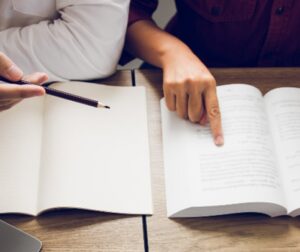 Due to a reliance on visuality, DHH individuals feel an exorbitant amount of fatigue, and DHH individuals will “frequently complain of being more tired than hearing people from focusing on visual information all day” (Schild & Dalenberg, 2016, p. 877-878). Such was my experience. I relied primarily on lip reading during spoken communication, and lip reading requires intense concentration to do well, even for a few minutes. More importantly, it is highly imprecise (see my article on this, published in 2018) and requires an enhanced cognitive load to fill in the “gaps” of communication. As such, DHH individuals are working much harder for less information. To combat this, be self-conscious about workload.
Due to a reliance on visuality, DHH individuals feel an exorbitant amount of fatigue, and DHH individuals will “frequently complain of being more tired than hearing people from focusing on visual information all day” (Schild & Dalenberg, 2016, p. 877-878). Such was my experience. I relied primarily on lip reading during spoken communication, and lip reading requires intense concentration to do well, even for a few minutes. More importantly, it is highly imprecise (see my article on this, published in 2018) and requires an enhanced cognitive load to fill in the “gaps” of communication. As such, DHH individuals are working much harder for less information. To combat this, be self-conscious about workload.
- Allow times in which the DHH student does not have to focus (literally) on the world around them. As a senior in high school, I had a “free” period in which I started taking daily naps; such helped reset my system each day.
- DHH students need visual breaks. One of the downsides of visual communication is that a teacher will know when a DHH is not “paying attention.” As such, teachers should resist the temptation to continually re-direct a DHH student’s attention back to visual communication (e.g. lips, signs, text, visuals). I have vivid flashbacks of a teacher calling me out, publicly, for not paying attention, which only expedites fatigue and anxiety. Hearing students are not always called out for inattention; DHH should not be called out, either.
- While perhaps not an option for most DHH students, I was homeschooled for a year and a half. Such allowed me to physically and emotionally recover from several years of DHH educational challenges.
Reading and Writing, Not Listening:
 For some DHH students with residual hearing, listening might serve as a gateway for learning a spoken language; however, the ultimate goal of education is to achieve high levels of literacy (a visual form of communication) and rely less on listening (an aural form of communication). Once a DHH student becomes a proficient reader, educators become mentors rather than teachers. While high literacy levels are a holy grail for many DHH individuals, if DHH individuals successfully achieve literacy like my sisters and I did, they become “bookworms” (Oliva, 2004, p. 2) with a love of literature and, subsequently, become authors themselves; DHH literature is replete with individuals who fit this mold: Brenda Jo Brueggeman, Henry Kisor, Noel Patrick O’Connell, Michael Chorost, Joseph Michael Valente, Haben Girma, Helen Keller, Paul Gordon Jacobs. Literacy unlocks the metaphorical “key” to language development and self-directed learning, which should be the end goal of traditional education.
For some DHH students with residual hearing, listening might serve as a gateway for learning a spoken language; however, the ultimate goal of education is to achieve high levels of literacy (a visual form of communication) and rely less on listening (an aural form of communication). Once a DHH student becomes a proficient reader, educators become mentors rather than teachers. While high literacy levels are a holy grail for many DHH individuals, if DHH individuals successfully achieve literacy like my sisters and I did, they become “bookworms” (Oliva, 2004, p. 2) with a love of literature and, subsequently, become authors themselves; DHH literature is replete with individuals who fit this mold: Brenda Jo Brueggeman, Henry Kisor, Noel Patrick O’Connell, Michael Chorost, Joseph Michael Valente, Haben Girma, Helen Keller, Paul Gordon Jacobs. Literacy unlocks the metaphorical “key” to language development and self-directed learning, which should be the end goal of traditional education.
- Encourage parents to read to their DHH children and to be involved in their literacy instruction. As Marschark and Hauser (2012) state, “[w]hen we look at only the best deaf readers, we find that there is essentially one factor that separates them from all of the others: the amount of parental involvement in their child’s education” (p. 108).
- Provide opportunities for learning via literacy, not face-to-face “hearing.” During high school, I enrolled in an introduction to computer programming class, and my teacher loaned me the instructor’s copy of the textbook when he discovered that I had a knack for programming but needed the visuality of a textbook to illustrate coding rather than “hearing” it.
- Encourage reading and writing as assignments out-of-class and activities within-class.
DHH Inclusion, Not Passing:
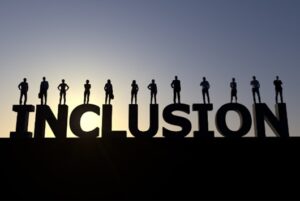 DHH individuals are under an extreme pressure to pretend that we hear more than we do. This technique is called “passing” in the literature, and it is a coping strategy that encourages DHH individuals to “overcome” something that cannot be overcome: to be hearing when we are not.
DHH individuals are under an extreme pressure to pretend that we hear more than we do. This technique is called “passing” in the literature, and it is a coping strategy that encourages DHH individuals to “overcome” something that cannot be overcome: to be hearing when we are not.
- Be self-aware about how certain activities require “hearing” and will force students into a passing performance. I recall being in Bible classes (I was in a private school for half of my K-12 education) where I could not hear the prayers when my “head is bowed” and my “eyes are closed.” Children are less able to advocate for themselves and ask for their eyes to remain open; as such, we learn to “pretend” that we are hearing the prayer via eye peaks and listening to acoustic information besides the prayer (e.g. crowd noise).
- Help to redirect passing behaviors toward more inclusive communications. When you see your DHH student nodding their head without knowing what is said or fake laughing at a joke or bowing their head during a prayer, make modifications to the communication dynamics. Resist the temptation to say “I’ll tell you later” or “It is not important.” Passing is most dangerous to mental health because it eliminates reciprocity in communication: both parties expect to be “heard” during conversations, and passing eliminates that expectation. As such, some DHH individuals are “least alone when [they are] alone” (Meadow-Orlans & Orlans, 1990, p. 424), a paradox that emerges from knowing that “hearing” individuals will exclude “DHH” individuals from conversations and “passing” allows for one to pretend that one is not excluded.
- Connect DHH individuals to other DHH individuals. DHH individuals who are mainstreamed will often be more socially isolated and lonely. In one poignant example in the literature, a DHH teenager who played sports, was a Girl Scout, and was active in her church and community reported that “she is lonely” (Charlson et al, 1992, p. 265, emphasis mine). She suggested that knowing American Sign Language (ASL) would have helped with this isolation. As such, mainstreamed DHH individuals tend to be on an “island of misfits” (Cue et al, 2019, p. 418). We are not part of Hearing World, and during mainstreamed class periods, we are isolated from Deaf culture.
DHH Advocacy, Not Resignation:
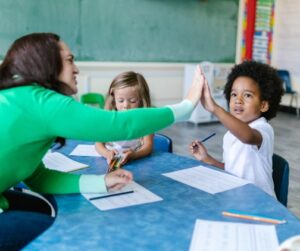 Education embraces the Greek aphorism of “know thyself.” When a DHH student matriculates, they must know that they are a DHH individual living in a “Hearing World,” capable of adapting to that world and advocating for change. Teachers can facilitate that.
Education embraces the Greek aphorism of “know thyself.” When a DHH student matriculates, they must know that they are a DHH individual living in a “Hearing World,” capable of adapting to that world and advocating for change. Teachers can facilitate that.
- Teach your DHH students by both encouraging and modeling strong advocacy. If students are excluded from educational situations, intervene.
- Engage in dialogue. Ask how your DHH student is feeling, and with their approval, assist them in making changes. Dialogue allows DHH students to know that they matter and that they can successfully demand change.
- Create a d/Deaf environment. Learn and teach introductory sign language and the ASL alphabet so that names/words/ideas can be more easily shared. I have positive memories of learning a person’s name for the first time and my friend (who knew the ASL alphabet) signed the name for me. Such creates an inclusive environment built on visuality, rather than orality.
- Embrace d/Deaf pride and read the literature surrounding “Deaf Gain” which focuses on the gains of being DHH rather than the loss of hearing. Today, I am proud to be DHH, something that I would not have claimed during my educational years: I have a unique cognition, epistemology, knowledge, and life-experience. These gains should be showcased to students. The edited collection of Deaf Gain: Raising the Stakes for Human Diversity (2014) might be a good place to start.
- Lastly, allow your DHH student to invert the educational experience: DHH students should educate the educators. Remember that 25% of all people will have measurable hearing loss by 2050 according to the World Health Organization (2021). True change begins when educators stop viewing DHH and disability as a “headache that won’t go away” and, instead, adopt a “reversal” (Baker, 2022, p. 697) where you recognize that you have your own hearing limitations, will (someday, if not today) be DHH, and might learn from your DHH students today.
References:
Baker, B. (2002). The Hunt for Disability: The New Eugenics and the Normalization of School
Children. Teachers College Record, 104(4), 663-703.
Bauman, H. D. L. & Murray, J. J., (Eds). (2014). Deaf Gain: Raising the Stakes for Human Diversity. Minneapolis, MN: University of Minnesota Press.
Charlson, E., Strong, M., & Gold, R. (1992). How successful deaf teenagers experience and cope with isolation. American Annals of the Deaf, 137(3), 261-270.
Cue, K. R., Pudans-Smith, K. K., Wolsey, J.-L. A., Wright, S. J., & Clark, M. D. (2019). The Odyssey of Deaf epistemology: A search for meaning-making. American Annals of the Deaf, 164(3), 395–422.
Hauser, P. C., O’Hearn, A., McKee, M., Steider, A., & Thew, D. (2010). Deaf epistemology: Deafhood and deafness. American Annals of the Deaf, 154(5), 486-492.
Lane, H., Pillard, R. C., & Hedberg, U. (2011). The people of the eye: Deaf ethnicity and ancestry. New York, NY: Oxford University Press.
Marschark, M. & Hauser, P. (2012). How deaf children learn: What parents and teachers need to know. New York, NY: Oxford University Press.
Meadow-Orlans, K. P. & Orlans, H. (1990). Responses to loss of hearing in later life. In D. F. Moores & K. P. Meadow-Orlans (Eds.) Educational and Developmental Aspects of Deafness. Washington, D.C.: Gallaudet University Press.
Oliva, G. A. (2004). Alone in the mainstream: A Deaf woman remembers public school. Washington, D.C.: Gallaudet University Press.
Schild, S., & Dalenberg, C. J. (2016). Information deprivation trauma: Definition, assessment, and interventions. Journal of Aggression, Maltreatment & Trauma, 25(8), 873-889.
World Health Organization. (2021, March 12). WHO: 1 in 4 people projected to have hearing problems by 2050. Retrieved January 22, 2024, from https://www. who. int/news/item/02-03-2021-who-1-in-4-peopleprojected-to-have-hearing-problems-by-2050.2021-03-21.
Wrigley, O. (1996). The politics of deafness. Washington DC: Gallaudet University Press.
About the Author:
 Kevin Garrison is a deaf/hard-of-hearing professor of English at Angelo State University. He resides in the central spaces between DEAF-WORLD and Hearing World, and his writings grapple with the challenges of being oral deaf. He has published academic articles, poetry, memoir, and more. More information about his vitae and writings can be found here: https://www.angelo.edu/live/profiles/361-kevin-garrison
Kevin Garrison is a deaf/hard-of-hearing professor of English at Angelo State University. He resides in the central spaces between DEAF-WORLD and Hearing World, and his writings grapple with the challenges of being oral deaf. He has published academic articles, poetry, memoir, and more. More information about his vitae and writings can be found here: https://www.angelo.edu/live/profiles/361-kevin-garrison
